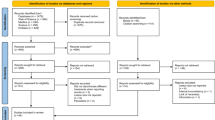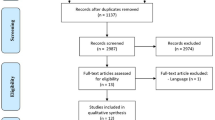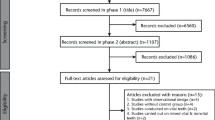Abstract
Aim
The main objective of this systematic review is to comprehensively evaluate all the relevant studies to evaluate the effectiveness of electrical stimulation to accelerate orthodontic tooth movement in human patients.
Methods
Using a suitable search strategy, various databases like PubMed, CENTRAL, Scopus and Google Scholar were surveyed for relevant randomized controlled trials (RCTs); after which a hand search of related orthodontic journals was completed. The risk of bias of studies was checked using Cochrane’s ROB-2 tool. The quality of evidence of the included studies was evaluated using the Grading of Recommendations, Assessment, Development, and Evaluation (GRADE) framework. Rate of orthodontic tooth movement was compared and thus efficiency of electrical stimulation to accelerate tooth movement was assessed. Meta-analysis was done on 2 studies out of the 4; rate of orthodontic tooth movement was compared at two time periods after start of treatment (3rd month and 5th month) with standardized mean difference (SMD) as summary estimate, with p < 0.05 denoting statistical significance. Publication bias was checked using a funnel plot.
Results
Via exploration of the online databases and hand searching, 1080 studies were found after removing duplicates. After full text assessment, 13 studies in total were selected that used electrical stimulation, out of which 4 studies were included in the qualitative analysis as they met the inclusion criteria. The meta-analysis was done for 3rd month and 5th month with SMD as 0.69(−1.26–0.12) and 1.64(−3.44–0.16), respectively. The strength of evidence in the meta-analysis is moderate. There was no publication bias as shown by funnel plot.
Discussion
The studies included showed increased risk of selection and performance bias. Also due to the limited number of studies available, there was difficulty in reaching definitive conclusions. The meta-analysis showed a significant difference among the control and experimental group for the 3rd month.
Conclusion
Even though a positive correlation is found between electrical stimulation and acceleration of orthodontic tooth movement, it is advised to conduct further studies, particularly with human participants, to establish a more conclusive outcome.
Registration
This review has received no funding. The protocol for the study was registered in the Prospective Registration of Systematic Review (PROSPERO)(CRD42023495077).
This is a preview of subscription content, access via your institution
Access options
Subscribe to this journal
Receive 4 print issues and online access
$259.00 per year
only $64.75 per issue
Buy this article
- Purchase on Springer Link
- Instant access to full article PDF
Prices may be subject to local taxes which are calculated during checkout






Similar content being viewed by others
Data availability
All data supporting the findings of this systematic review and meta-analysis are available within the paper and its supplementary information. The included studies are given in references 14, 16, 17 and 18. If additional data is required, it can be obtained by contacting the corresponding author. Also, if additional data is required, it can be obtained by contacting the corresponding author.
References
Nimeri G, Kau CH, Abou-Kheir NS, Corona R. Acceleration of tooth movement during orthodontic treatment - a frontier in Orthodontics. Prog Orthod. 2013;14:42.
Gadakh SB, Gulve N, Patani S, Nehete A, Aphale H, Patil H. Methods of accelerating orthodontic treatment – A review. J Appl Dent Med Sci. 2016;2:101–5.
Unnam D, Singaraju GS, Mandava P, Reddy GV, Mallineni SK, & Accelerated Orthodontics - An overview. J Dent Craniofac Res. 2018;3:4.
Jung JG, Park JH, Kim SC, Kang KH, Cho JH, Cho JW, et al. Effectiveness of pulsed electromagnetic field for pain caused by placement of initial orthodontic wire in female orthodontic patients: A preliminary single-blind randomized clinical trial. Am J Orthod Dentofacial Orthop. 2017;152:582–91. https://doi.org/10.1016/j.ajodo.2017.04.022
Miguel, Mathias MMV, Santamaria IF, Rossato A, Ferraz LFF, Figueiredo-Neto AM, et al. Microcurrent electrotherapy improves palatal wound healing: Randomized clinical trial. J Periodontol. 2021;92:244–56. https://doi.org/10.1002/JPER.20-0122
Davidovitch Z, Finkelson M, Steigman S, Shanfeld J, Montgomery P, Korostoff E. Electric currents, bone remodeling, and orthodontic tooth movement. II. Increase in the rate of tooth movement and periodontal cyclic nucleotides by combined force and electric currents. Am J Orthod. 1980;77:33–47.
Showkatbakhsh A, Younessian F, Dianat O, Seyed Izadi SS, Mehrdad MB, Showkatbakhsh A, et al. Effect of intra-canal direct current electric stimulation on orthodontic tooth movement: An experimental study in canines. J Dent School. 2016;34:157–67.
Thomas NI, Stark P, Sinclair PM. Effect of pulsed electromagnetic fields on orthodontic tooth movement. Am J Orthod Dentofacial Orthop. 1987;91:91–104.
Darendeliler MA, Sinclair PM, Kusy RP. The effects of samarium-cobalt magnets and pulsed electromagnetic fields on tooth movement. Am J Orthod Dentofacial Orthop. 1995;107:578–88.
Dogru M, Akpolat V, Dogru AG, Karadede B, Akkurt A, Karadede MI. Examination of extremely low-frequency electromagnetic fields on orthodontic tooth movement in rats. Biotechnol Biotechnol Equip. 2014. https://doi.org/10.1080/13102818.2014.901669
Spadari GS, Zaniboni Scudeler SA, Santamaria V, Santamaria MP, Tech dos Santos GM, Esquisatto MAM, et al. Electrical stimulation enhances tissue reorganization during orthodontic tooth movement in rats. Clin Oral Investig. 2017;21:111–20.
Agarwal A, Dwivedi P, Chaturvedi TP, Mittal N. Effect of Electrical Stimulation on Orthodontic Tooth Movement: A Systematic Review. Int J Orthod. 2019;30:62–71.
Page MJ, McKenzie JE, Bossuyt PM, Boutron I, Hoffmann TC, Mulrow CD, et al. The PRISMA 2020 statement: an updated guideline for reporting systematic reviews. BMJ. 2021;372:n71 https://doi.org/10.1136/bmj.n71
Kim DH, Park YG, Kang SG. The effects of electrical current from a micro-electrical device on tooth movement. Korean J Orthod. 2008;38:337 https://doi.org/10.4041/kjod.2008.38.5.337
Higgins JPT, Thomas J, Chandler J, Cumpston M, Li T, Page MJ, Welch VA (editors). Cochrane Handbook for Systematic Reviews of Interventions version 6.4 (updated August 2023). Cochrane, 2023. Available from www.training.cochrane.org/handbook.
Barsi P, Santamaria M, Casarin R, Vedovello S, Zuppardo M, Bautista C, et al. Can bioelectrical stimulation favor orthodontic treatment? A randomized clinical trial to evaluate tooth movement, patient-centered, and inflammatory biomarker outcomes. AJO-DO Clin Companion. 2023. https://doi.org/10.1016/j.xaor.2023.09.004
Showkatbakhsh R, Jamilian A, Showkatbakhsh M. The effect of pulsed electromagnetic fields on the acceleration of tooth movement. World J Orthod. 2010;11:e52–6.
Bhad Patil WA, Karemore AA. Efficacy of pulsed electromagnetic field in reducing treatment time: A clinical investigation. Am J Orthod Dentofacial Orthop. 2022;161:652–8. https://doi.org/10.1016/j.ajodo.2020.12.025
Davidovitch Z, Finkelson MD, Steigman S, Shanfeld JL, Montgomery PC, Korostoff E. Electric currents, bone remodeling, and orthodontic tooth movement: I. The effect of electric currents on periodontal cyclic nucleotides. Am J Orthod. 1980;77:14–32.
Author information
Authors and Affiliations
Contributions
AP and SDM- Helped in framing the concept and idea generation for the review, also gave overall guidance and approved the final draft. SD- Data assembly, organization and management; writing manuscript, conducting statistical analysis and interpretations of results. TR- Data assembly, organization and management.
Corresponding author
Ethics declarations
Competing interests
The authors declare no competing interests.
Additional information
Publisher’s note Springer Nature remains neutral with regard to jurisdictional claims in published maps and institutional affiliations.
Rights and permissions
Springer Nature or its licensor (e.g. a society or other partner) holds exclusive rights to this article under a publishing agreement with the author(s) or other rightsholder(s); author self-archiving of the accepted manuscript version of this article is solely governed by the terms of such publishing agreement and applicable law.
About this article
Cite this article
Dutta, S., Rout, T., Patil, A.S. et al. Use of electrical stimulation for accelerated orthodontics in humans: a systematic review and meta-analysis. Evid Based Dent (2024). https://doi.org/10.1038/s41432-024-00997-6
Received:
Accepted:
Published:
DOI: https://doi.org/10.1038/s41432-024-00997-6



